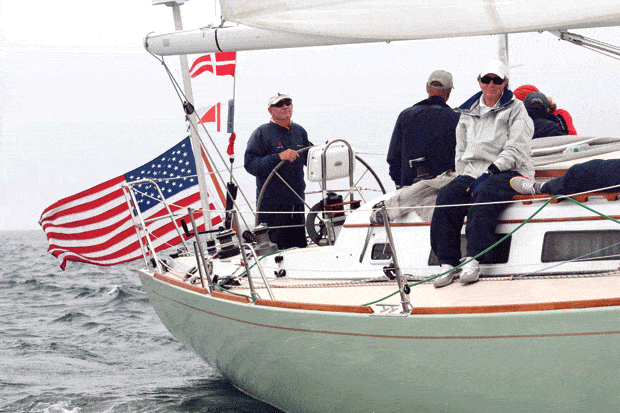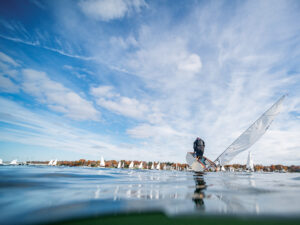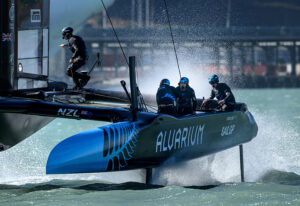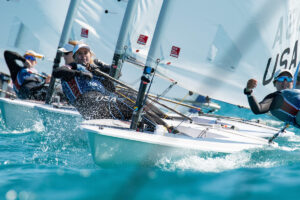
Curtis Revival
At Storm Trysail Club’s 25th Anniversary Block Island Race Week in June, the stars aligned for 67-year-old Dave Curtis, of Marblehead, Mass., one of the greats of one-design sailing and one of the first college sailing All-Americans. On the eve of Race Week’s hotly contested Around the Island Race, the National Sailing Hall of Fame announced Curtis’ induction with the class of 2013. The following morning, with an amateur crew and a raceboat more classic than high-performance, Curtis grabbed the spotlight again, claiming the race’s overall title and a Rolex watch—a third to add to the two he collected as the Rolex Yachtsman of the Year in 1981 and 1983.
There must be something about Block Island that suits Curtis, for it was back in 1977 that he arrived on the island sailing a new one-design called the J/24. Curtis lived on the boat for the week, along with a few of the Johnstone kin, and the team won all but one race. This year Curtis raced his Jim Taylor-designed 38-footer Rival and fittingly won all but one race. The crew included his wife, Joanne, their daughter Gretchen, his brother Jon, Katie Smith, retired sailmaker Jim Crane, and pickup crew Dan Barry, who Curtis found online at the regatta’s “available crew” list registry. As I’m sure Barry will agree, if you want to race and need a ride, don’t be afraid to put your name out there—you never know who might draft you.
Curtis and crew sailed almost perfectly, only losing the final race, which took place after a three-hour postponement on a foggy and rough Block Island Sound.
“We waited a long time for the start because of thick fog,” says Curtis, explaining his one loss to Dave Alldian’s Sabre 362 Cymothoe. “We were kind of lethargic after rolling in big swells for several hours. We did set our sails and tune up a few times during the long delay, but we got complacent waiting. Somehow I jumped the gun at the start, and we had the wrong jib up. We were able to catch up to the other boats, but we didn’t save our time on Cymothoe.”
There’s a lesson for us all: Be ready to race before the starting gun fires.
The name of the Curtis family boat, Rival, intrigued me, and when I pressed him for the story, he was happy to oblige. “It was the name of my father’s schooner. He sailed it in the 1930s. It was a B.B. Crowninshield design. It seemed like a fitting tribute to my father’s boat.”
All of the one-design crafts in which Curtis amassed national and world championship titles—Solings, Etchells, and J/24s—were named Whip, a word heard frequently around Marblehead where he grew up. And while Curtis has remained a fixture of the Marblehead racing scene, he’s much less visible on the international racing circuit these days. It had been decades since his last Block Island Race Week. The reason for his return, however, was understandable.
“Two years ago I told my daughter we could do the Halifax Race,” says Curtis. “She had never sailed an overnight race. I don’t like overnight racing, but she loves sailing. Unfortunately, I was unable to get Rival ready in time, so I offered her an alternative—to go to Block Island. She liked the idea, and that’s how we got back.”
“So,” I ask, “How was it?”
“It was cool,” he says enthusiastically. “The party atmosphere is better now. There are a lot more boats now compared with the past.”
When asked how he was able to win so handily, he said it took him a while to figure out how to sail the boat. “I’ve learned how to make small adjustments to improve speed,” he says. “I like the Jim Taylor design. At first he told me not to start to windward of anyone because the boat doesn’t point too high with its shallow keel, but we found it does very well to windward.”
Curtis spent his career as a successful sailmaker, and for 30 years he competed at the top of the sport in several one-design classes. “It had to be a big class so lots of sails were built each year,” he says. “The sails had to be expensive enough to justify all the effort you put into it. Keelboats were right up my alley. I wasn’t trying to be the biggest sailmaker, just the best in my market. We spent a lot of time on quality control.”
During our conversation, Curtis confessed that he has owned 20 different Etchells and 10 Solings over the years. That seems like a lot of boats, but he says, “[One-design] boats are not identical; the differences can be small but just enough to throw the tuning off. There’s no substitute for spending time in a boat, whether you’re racing or not.”
Another key to his success has been his partnering with excellent crews, he says. “The crew had to be really good. You need the same crew all the time. I had the same crew. They knew how everything worked and how I did everything.”
As he spends much of his time cruising and casually racing these days, he says it’s unlikely we’ll ever see him as devoted to one-design sailing as he was in his best years. “I don’t want to travel as much as I once did. I went through a phase where I did a lot of sailing all over the world. It was great fun, but it was hard work at the highest level. I guess I got burned out more than anything else.”
But that doesn’t mean he takes the sport any less seriously when he does race. “When the starting gun goes off the adrenaline comes back,” he says. “I missed that for a while, but now I feel the need to win. I’m so competitive in everything, whether playing golf or a card game. I don’t know if other people feel that way.”
Over the past several years Curtis has sailed with his daughter Gretchen. “She is very good,” he says with paternal pride. “She’s an unbelievable driver. I sit there and trim the sails. Maybe I trim the sails differently, but we have had more success in the Sonar when I’m crewing than when I’m driving. We also sailed a Viper for four years with Gretchen driving, when she was only 14 or 15. The boat doesn’t have much feel, but she did well.”
Much of his daughter’s talent came to her as it did to Curtis. “When I was a kid I would sail every single day. After school I’d usually sail alone, spending thousands of hours over the course of five years. It got to be the same when I was in a Soling or an Etchells. You have to be comfortable in how the boat moves and tacks and jibes. I would miss another boat by two inches.”
Curtis still laughs at one incident that almost turned disastrous. “Dennis Conner was here for Marblehead Race Week. In the first race I ducked him. I said, ‘I’m just going to show him I’ve got nerves of steel.’ So I waited until the last second, and as I went to bear off, the hiking stick came off. I grabbed the tiller and just pulled as hard as I could and missed him—by half an inch. Afterward he came in and said, ‘Boy you really cut it close out there, don’t you think?’ If he only knew the half of it.”









